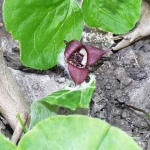| Common Name: |
Wild Ginger |
| Botanical Name: |
Asarum canadense |
| Genus: |
Asarum |
| Family: |
Aristolochiaceae |
| Native Location: |
Eastern N America |
| Cultivation: |
Well-drained, moist soil, enriched with leaf mold, in a shady, sheltered site. |
| Propagation: |
By seed sown when ripe; by division in early spring. |
| Harvest: |
Sections of rhizome are removed in autumn, and dried for powders, decoctions, liquid extracts, and tinctures. |
| Height: |
8cm (3in) |
| :Width |
60cm (24in) |
| Hardiness: |
Z3-8 |
| Parts Used: |
Rhizomes |
| Properties: |
A bitter, pungent, aromatic, antibiotic herb that stimulates the digestive and respiratory systems, and uterus, and increases perspiration. It acts as a diuretic, expectorant, and decongestant. |
| Medicinal Uses: |
Internally for coughs, asthma, chills, and rheumatic disorders. Women of the N American Pomo tribe take wild ginger as a contraceptive, and in Western medicine it is used to regulate menstruation and as a stimulant in difficult labor (but not in earlier stages of pregnancy). The Ojibwa tribe combined it with Aralia racemosa (see American spikenard) in poultices for fractures. Not given to pregnant women. |
| Culinary Uses: |
Ginger-flavored rhizomes are candied or made into a syrup. |
| Bibliography: |
Encylopedia of Herbs by Deni Brown Copyright ©: 1995, 2001 Dorling Kindersley Limited pg 134
|

